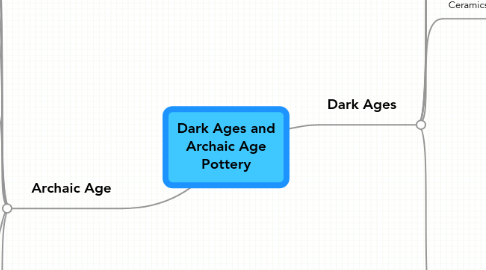
1. Archaic Age
1.1. 800-467 BCE
1.2. People began to settle down
1.2.1. Still not completely peaceful yet
1.3. People began trading pots
1.4. Development of the alphabet
1.4.1. Stolen from the Canaanites
1.5. Black-Figure Vases
1.5.1. Details were scratched in
1.5.1.1. Cannot make many curves
1.5.1.2. Could easily chip the vase
1.5.2. Not much emotion shown in faces
1.5.3. Showed the rise of drama
1.5.3.1. The main focus of the art on the vase acted as a stage
1.6. Red-Figure Vases
1.6.1. More modern then Black-Figure
1.6.2. Can add more detail
1.6.2.1. Figures look more life-like
1.6.2.2. Easier to draw figures
1.6.3. Cannot chip the vase
1.6.4. Can have curves
1.7. Why was pottery so important?
1.7.1. Greek culture spread through the pottery when traded
1.7.2. Other cultures adopted Greek gods and dress through pottery
1.7.3. Pottery was the reason why the Mediterranean copied Greece
1.7.4. Moved from a focus on the divine to the humans
2. Dark Ages
2.1. 1200-800 BCE
2.2. No architecture
2.3. No frescoes
2.4. Small, crude sculptures
2.4.1. Not artistic
2.5. Ceramics
2.5.1. Lekythos
2.5.1.1. Used to pour and store oil
2.5.2. Krater
2.5.2.1. Used to mix water and wine
2.5.3. Oenochoe
2.5.3.1. Used to pour the mixed water and wine
2.5.4. Kylix
2.5.4.1. Used as a drinking cup
2.5.5. Amphora
2.5.5.1. Used to store liquids and dry goods
2.5.5.2. 750 BCE
2.5.5.3. Commonly made as a grave marker
2.5.6. Hydria
2.5.6.1. Used to pour water and other liquids
2.5.6.2. 1800 BCE
2.6. Six main characteristics of Greek vase painting
2.6.1. Horror vacui
2.6.1.1. The need to fill every little space with some sort of decoration
2.6.1.1.1. Fear of angry gods coming through the spaces
2.6.2. Rigid Division of a base into a rational and balanced order
2.6.3. Geometric shapes
2.6.3.1. Mainly used shapes such as triangles and diamonds.
2.6.3.2. Circles were uncommon in Athenian artwork
2.6.4. Horizontal lines
2.6.4.1. Three horizontal lines separated each picture or change of decoration
2.6.5. Main scene
2.6.5.1. Places in the center of the vase in between the handles
2.6.6. People and animals were created in crude geometric parts
2.6.6.1. Shows lack of artistic skill
